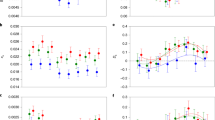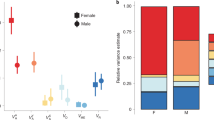Abstract
Rapid divergent evolution of male genitalia is one of the most general evolutionary trends in animals with internal fertilization; the shapes of genital traits often provide the only reliable characters for species identification1. Yet the evolutionary processes responsible for this pattern remain obscure. The long-standing lock-and-key hypothesis, still popular among taxonomists, suggests that genitalia evolve by pre-insemination hybridization avoidance; that is, hybrid inferiority drives the evolution of male genitalia with a proper mechanical fit to female genitalia. The sexual selection hypothesis2,3, in contrast, proposes that divergent evolution of genitalia is the result of sexual selection, brought about by variation in postinsemination paternity success among males. Here, by comparing pairs of related clades of insects that differ in mating system, I assess how the opportunity for postmating sexual selection affects the rate of divergent evolution of male genitalia. Genital evolution is more than twice as divergent in groups in which females mate several times than in groups in which females mate only once. This pattern is not found for other morphological traits. These findings provide strong empirical evidence in favour of a postmating sexual selection mechanism of genital evolution.
This is a preview of subscription content, access via your institution
Access options
Subscribe to this journal
Receive 51 print issues and online access
$199.00 per year
only $3.90 per issue
Buy this article
- Purchase on Springer Link
- Instant access to full article PDF
Prices may be subject to local taxes which are calculated during checkout

Similar content being viewed by others
References
Eberghard, W. G. Sexual Selection and Animal Genitalia(Harvard Univ. Press, Cambridge, MA, 1985).
Eberhard, W. G. Evaluating models of sexual selection: genitalia as a test case. Am. Nat. 142, 564–571 (1993).
Eberhard, W. G. Females Control: Sexual Selection by Cryptic Female Choice(Princeton Univ. Press, Princeton, NJ, 1996).
Lloyd, J. E. Mating behavior and natural selection. Fla. Entomol. 62, 17–34 (1979).
Thornhill, R. Cryptic female choice and its implications in the scorpionfly Harpobittacus nigriceps. Am. Nat. 122, 765–788 (1983).
Waage, J. K. Dual function of the damselfly penis: sperm removal and transfer. Science 203, 916–918 (1979).
Gage, M. J. Removal of rival sperm during copulation in a beetle, Tenebrio molitor. Anim. Behav. 44, 587–589 (1992).
Arnqvist, G. & Rowe, L. Sexual conflict and arms races between the sexes: a morphological adaptation for control of mating in a female insect. Proc. R. Soc. Lond. B 261, 123–127 (1995).
Rice, W. R. Sexually antagonistic male adaptation triggered by experimental arrest of female evolution. Nature 381, 232–234 (1996).
Alexander, R. D., Marshall, D. C. & Cooley, J. R. in The Evolution of Mating Systems in Insects and Arachnids(eds Choe, J. C. & Crespi, B. J.) 4–31 (Cambridge Univ. Press 1997).
Verell, P. A. Primate penile morphologies and social systems: further evidence for an association. Folia Primatol. (Basel) 59, 114–120 (1992).
Harcourt, A. H. & Gardiner, J. Sexual selection and genital anatomy of male primates. Proc. R. Soc. Lond. B 255, 47–53 (1994).
Proctor, H. C., Baker, R. L. & Gwynne, D. T. Mating behaviour and spermatophore morphology: a comparative test of the female-choice hypothesis. Can. J. Zool. 73, 2010–2020 (1995).
Lestrel, P. E. (ed) Fourier Descriptors and their Applications in Biology(Cambridge Univ. Press, 1997).
Rohlf, F. J. in Ordination in the Study of Morphology, Evolution and Systematics of Insects(eds Sorensen, J. T. & Foottit, R.) 95–112 (Elsevier, Amsterdam, 1992).
Arnqvist, G. The evolution of animal genitalia: distinguishing between hypotheses by single species studies. Biol. J. Linn. Soc. 60, 365–379 (1997).
Darwin, C. The Descent of Man, and Selection in Relation to Sex(Murray, London, 1871).
Andersson, M. Sexual Selection(Princeton Univ. Press, Princeton, NJ, 1994).
Pomiankowski, A. & Møller, A. P. Aresolution of the lek paradox. Proc. R. Soc. Lond. B 260, 21–29 (1995).
Rowe, L. & Houle, D. The lek paradox and the capture of genetic variance by condition dependent traits. Proc. R. Soc. Lond. B 263, 1415–1421 (1996).
Burt, A. Comparative methods using phylogenetically independent contrasts. Oxf. Surv. Evol. Biol. 6, 33–53 (1989).
Harvey, P. H. & Pagel, M. D. The Comparative Method in Evolutionary Biology(Oxford Univ. Press, 1991).
Thornhill, R. & Alcock, J. The Evolution of Insect Mating Systems(Harvard Univ. Press, Cambridge, MA, 1983).
Ridley, M. The timing and frequency of mating in insects. Anim. Behav. 37, 535–545 (1989).
Ridley, M. The incidence of sperm displacement in insects: four conjectures, one corroboration. Biol. J. Linn. Soc. 38, 349–367 (1989).
Ridley, M. The control and frequency of mating in insects. Funct. Ecol. 4, 75–84 (1990).
Ferson, S., Rohlf, F. J. & Koehn, R. K. Measuring shape variation of two-dimensional outlines. Syst. Zool. 34, 59–68 (1985).
Rohlf, F. J. & Archie, J. Acomparison of Fourier methods for the description of wing shape in mosquitoes (Diptera: Culicidae). Syst. Zool. 33, 302–317 (1984).
Liu, J. et al. Genetic analysis of a morphological shape difference in the male genitalia of Drosophila similans and D. mauritiana. Genetics 142, 1129–1145 (1996).
Acknowledgements
I thank L. Rowe and P. Watson for comments. This study was made possible by the expert advice from many entomologists (see Supplementary information), and was generously funded by a grant from the Swedish Natural Science Research Council.
Author information
Authors and Affiliations
Corresponding author
Supplementary Information
Rights and permissions
About this article
Cite this article
Arnqvist, G. Comparative evidence for the evolution of genitalia by sexual selection. Nature 393, 784–786 (1998). https://doi.org/10.1038/31689
Received:
Accepted:
Issue Date:
DOI: https://doi.org/10.1038/31689
This article is cited by
-
Do male reproductive traits evolve at the intraspecific level in response to the amount of placentotrophy in a genus of viviparous fishes?
Evolutionary Ecology (2023)
-
Male genital lobe morphology affects the chance to copulate in Drosophila pachea
BMC Ecology and Evolution (2021)
-
Relevance of ddRADseq method for species and population delimitation of closely related and widely distributed wolf spiders (Araneae, Lycosidae)
Scientific Reports (2021)
-
Successful mating and hybridisation in two closely related flatworm species despite significant differences in reproductive morphology and behaviour
Scientific Reports (2020)
-
The Evolution of Ecosystem Phenotypes
Biological Theory (2020)
Comments
By submitting a comment you agree to abide by our Terms and Community Guidelines. If you find something abusive or that does not comply with our terms or guidelines please flag it as inappropriate.



